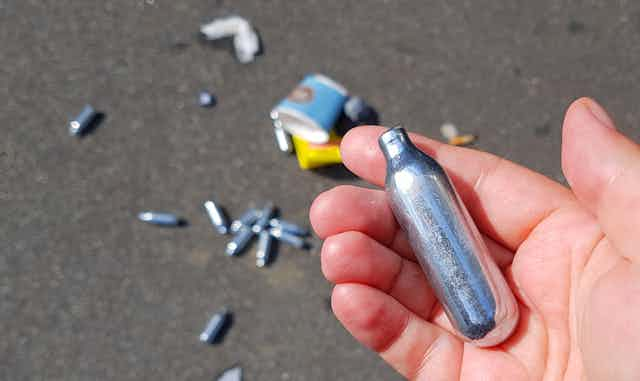Three and a half tonnes of nitrous oxide canisters were collected at Notting Hill carnival in London this year. According to the Crime Survey for England and Wales, nitrous oxide (also known as nos, whippits and laughing gas) is the second most commonly used recreational drug after cannabis among 16- to 24-year-olds.
Nitrous oxide use is a growing and worrying trend. One of the authors (Nikos Evangelou) was on call last week at an NHS hospital in Nottingham when an 18-year-old man was admitted unable to move his legs due to inhaling too much nos. The same week, another young man came to the emergency department with similar but milder symptoms after nos exposure. Two GPs also called in the same week for advice about three young patients with very similar symptoms after inhaling nos.
The 18-year-old patient told us that two of his friends developed numbness in their legs and unsteadiness after using nos. It took them eight months to recover. And last month, another young man in Nottingham was admitted to hospital with exactly the same symptoms.
Typical neurological symptoms due to nos inhalation include tingling in the feet, which can spread to the hands, and unsteadiness while walking or numbness in the legs. If not treated and the person continues to use nos, it can lead to weakness in the arms and legs as well as problems with memory. Even when patients are being treated, many will remain disabled for months or years.
We hardly ever encountered nos-related neurological problems a year ago – and we are not alone. We have spoken to other neurology units in the UK, and it appears to be happening all over the UK.
And in the Netherlands, the Dutch Poisons Information Center reported last year that the rate of NOS poisonings had increased alarmingly.
Nitrous oxide is an anaesthetic gas with pain-relieving and anti-anxiety properties. As part of medical training, anaesthetists and neurologists learn about the potential harms of this colourless gas, but until recently, it was mainly an exam question of the type: “What type of neuropathy (disease of the nerves) are dentists more likely to get?”
A report in The Lancet in 1978 raised the alarm for the same neurological disorder we now see, caused by prolonged exposure to nitrous oxide in 15 patients, all but one of whom were dentists. Now, with better regulations and education, dentists are unlikely to suffer from nos-related nerve damage.
Most of us hardly met a patient with nos-related neuropathy before last year.

How it damages nerves
Nitrous oxide causes nerve damage because it inactivates vitamin B12. This vitamin is essential for maintaining healthy myelin, the insulation that surrounds our nerves. When vitamin B12 is lacking or when it becomes inactivated, the nerves malfunction and people become unsteady or paralysed.
A study from France found that men are six times more likely than women to suffer from nos-related nerve damage. But women are actually more vulnerable because they are more likely to have B12 deficiency. So the study’s findings reflect the higher usage of nos by men. (Vegetarians and vegans also lack vitamin B12, so they are theoretically also at higher risk of nerve damage if they use nos.)
The more doses inhaled, the higher the risk. Some patients have reported more than 100 doses (balloons) per session. This is probably the reason for the recent wave of cases we have seen.
Easily abused
Nos is easily abused because it’s cheap and easy to buy. It is sold in small aluminium canisters (whippits) that fill up one balloon, which users then inhale the gas from. During the last six to 12 months, though, large containers that can fill up to 80 or more balloons have been available to buy online.
These large containers have become much more common, costing around £25, making each dose even cheaper. We suspect that this has led to larger doses being inhaled by some users. Sadly, we need to be prepared for more young people being admitted to hospital.
Drug experts think that nitrous oxide use is unlikely to reduce as a result of a change in regulation or law enforcement. Realistically, education is our best weapon. We need to educate users to stop using nos when they first develop tingling and to immediately seek medical help. We also need to educate healthcare professionals to diagnose and treat nos-induced B12 deficiency. At the moment, this education is sorely lacking.

